NVIDIA Announces GeForce GTX 1050 Ti & GTX 1050: Entry-Level Cards Launching October 25th
by Ryan Smith on October 18, 2016 9:00 AM EST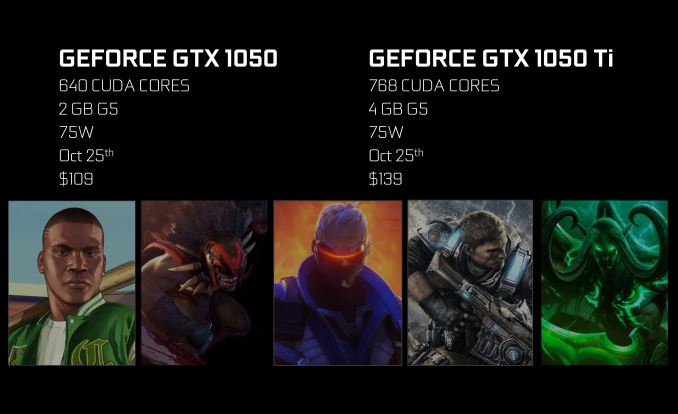
After a break of a couple of months in their Pascal launch schedule, NVIDIA is back again to launch a new Pascal desktop product. Following their near-perfect top-down launch schedule that started with GeForce GTX 1080 in May, being announced today and formally launching next week is the GeForce GTX 1050 Ti and GeForce GTX 1050. Aimed at the entry level discrete video card market, these products will round-out the GeForce 10-series desktop lineup.
Launching their low-tier cards last instead of first for the Pascal generation marks an interesting inverse of what happened with the Maxwell generation. In 2014 it was the low-end Maxwell 1 parts that launched first, only to be followed up by the other Maxwell 2 parts later on in the year. As a result, the Maxwell 2 family went through a full cycle – from release to retirement – before NVIDIA’s entry-level cards were refreshed. Out of all of the segments in the NVIDIA product stack, it’s fair to say that the entry-level was the one most due for a refresh.
And to that end, here we are with the GeForce GTX 1050 series. The previous GeForce GTX 750 series went very well for NVIDIA, so much so that the new 1050 series follows a number of beats laid out by its predecessor. NVIDIA is launching two cards – both of which are based on the new GP107 – which setup a two-tier product offering for the entry level market. The faster of the two cards is the GTX 1050 Ti, while the GTX 1050 follows closely to offer a bit less performance at a lower price point. And in order to maximize compatibility, both cards are being offered in configurations that draw their power entirely from the PCIe bus, forgoing the need for an external power connection.
| NVIDIA GPU Specification Comparison | |||||||
| GTX 1060 3GB | GTX 1050 Ti | GTX 1050 | GTX 750 Ti | GTX 750 | |||
| CUDA Cores | 1152 | 768 | 640 | 640 | 512 | ||
| Texture Units | 72 | 48 | 40 | 40 | 32 | ||
| ROPs | 48 | 32 | 32 | 16 | 16 | ||
| Core Clock | 1506MHz | 1290MHz | 1354MHz | 1020MHz | 1020MHz | ||
| Boost Clock | 1709MHz | 1392MHz | 1455MHz | 1085MHz | 1085MHz | ||
| Memory Clock | 8Gbps GDDR5 | 7Gbps GDDR5 | 7Gbps GDDR5 | 5.4Gbps GDDR5 | 5Gbps GDDR5 | ||
| Memory Bus Width | 192-bit | 128-bit | 128-bit | 128-bit | 128-bit | ||
| VRAM | 3GB | 4GB | 2GB | 2GB | 1GB | ||
| FP64 | 1/32 | 1/32 | 1/32 | 1/32 | 1/32 | ||
| TDP | 120W | 75W | 75W | 60W | 55W | ||
| GPU | GP106 | GP107 | GP107 | GM107 | GM107 | ||
| Transistor Count | 4.4B | 3.3B | 3.3B | 1.87B | 1.87B | ||
| Manufacturing Process | TSMC 16nm | Samsung 14nm | Samsung 14nm | TSMC 28nm | TSMC 28nm | ||
| Launch Date | 08/18/2016 | 10/25/2016 | 10/25/2016 | 02/18/2014 | 02/18/2014 | ||
| Launch Price | $199 | $139 | $109 | $149 | $119 | ||
Diving into the specs, we’ll start with the GTX 1050 Ti. Based on a fully enabled GP107 GPU, this card is arguably the backbone of NVIDIA’s entry-level offerings. All-told, it has 6 SMs enabled – 60% that of GP106/GTX 1060 – so GP107 is a bit more than half of a GP106. The rest of the Pascal architecture has been scaled similarly; GP107/GTX 1050 Ti retains 2/3rds of the ROP and memory controller configuration, meaning we’re looking at 32 ROPs attached to a 128-bit memory bus. Notably, this is double the number of ROPs found on GTX 750, so all other factors held equal, GTX 1050 Ti will see a massive jump in ROP throughput compared to its predecessor.
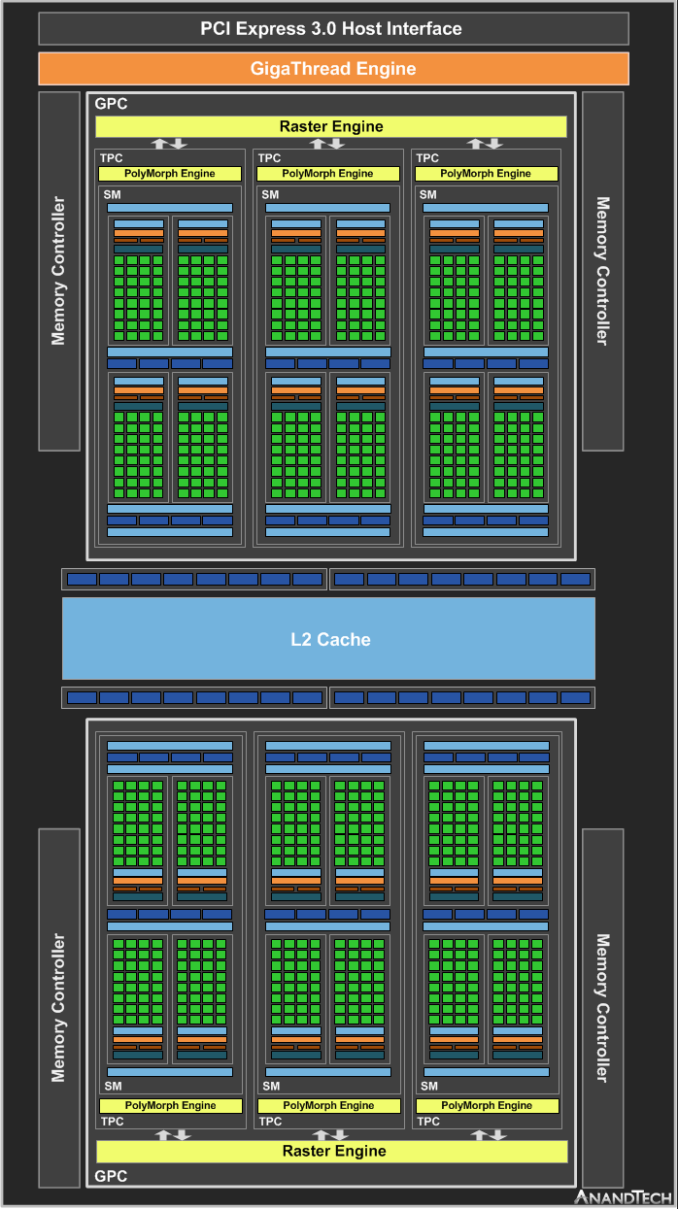
Unofficial GP107 Block Diagram
Feeding GTX 1050 Ti is 4GB of GDDR5 memory, clocked at 7Gbps. This is a budget card – and a power limited one at that – so NVIDIA has pulled back on the memory clocks compared to the other Pascal cards. Meanwhile power consumption starts at 75W, the maximum amount allowed to be pulled from a PCIe slot. I say “starts” because NVIDIA will be allowing partners to sell factory overclocked cards, and these cards will feature a higher TDP and an external power connector in order to meet the card’s power needs. The significance of offering a 75W-and-under card cannot be overstated; there is a sizable market for end users who would like to upgrade an OEM system but don’t have an external power connector, and this is a role the preceding GTX 750 filled very well. Meanwhile HTPC users who were holding out for a 75W card will be equally pleased, as now Pascal’s suite of media features are on a lower power card.
Joining the GeForce GTX 1050 Ti is its smaller, cheaper sibling, the GTX 1050. Based on a cut-down GP107 GPU, GTX 1050 drops 1 SM and 2GB of memory. This leaves us with a 5 SM (640 CUDA core) card paired with 2GB of GDDR5 running at 7Gbps. Otherwise it has the full ROP complement and memory bus, so while GTX 1050 loses some shader and geometry throughput, in other areas it holds firm. In fact due to the unusual clockspeeds of these cards – more on this in a moment – the GTX 1050 is actually clocked higher than the GTX 1050 Ti. So the net performance difference on paper is less than the loss of the SM; the smaller card should offer around 87% of the GTX 1050 Ti’s performance. With that said, unlike the last generation you don’t save any power versus the Ti card when going by the official TDP, as the GTX 1050 is also a 75W card, which happens to be 20W more than the GTX 750. Consequently while it’s still a card that can run on just PCIe slot power, by NVIDIA’s own numbers we may be looking at a relatively sizable increase in power consumption relative to its predecessor.
GP107 – An Enigma of a GPU
Having covered the basic specifications, I want to spill a bit more ink talking about the GP107 GPU. Reading the specs table, the GTX 1050 series cards are very unusual compared to their more powerful siblings. To be sure they’re still Pascal cards, but certain elements we take for granted about the Pascal family don’t apply here. At the same time there are certain elements we take for granted about x50 series cards which also aren’t applicable here. GP107 is, at the moment, an enigma of a GPU.
I’ll address what’s likely the elephant in the room first, which is the manufacturing process. To date all Pascal GPUs have been fabbed over at TSMC on their 16nm FinFET process. GP107 is not one of those GPUs. Instead, it’s fabbed on a 14nm process – NVIDIA’s specification sheet doesn’t technically state whose process – but by simple elimination it’s a very safe bet that they’re making the chip over at Samsung. Feature size is a red herring here, and instead the significance of this deal is that NVIDIA has not used a fab other than TSMC for GPUs for a long time. In fact we’d have to go back to 2003 to find an NVIDIA GPU fabbed somewhere else, when NVIDIA tapped IBM to help fab the ill-fated NV3x series (GeForce FX).
Suffice it to say, tapping another fab is a very big deal. There’s no second-sourcing here – GP107 is only being made on Samsung’s 14nm process and GP106+ only on TSMC’s 16nm process – but splitting orders like this may just as well be new territory for NVIDIA. As this is just a product announcement NVIDIA hasn’t said anything about the change in fabs, so let your imagination go wild here, but it definitely has some ramifications. I really need to get the GTX 1050 cards in house and on the testbed to figure out the full ramifications of this, but I think the most important change here is that a new process from a new vendor means that the voltage/frequency curve we’ve come to know with TSMC 16nm and Pascal has essentially been thrown out the window.
This in turn may explain the clockspeeds of the GTX 1050 cards. All of the other desktop GeForce 10-series cards have an official boost clock of 1600MHz+, with all but one of those cards being 1700Mhz+. The massive jump in clockspeed relative to Maxwell 2 is one of the signature elements of the Pascal architecture, and a major factor driving the significant performance gains of this generation compared to the last. The GTX 1050 series, by comparison, is only rated to boost up to 1455MHz for the GTX 1050, and lower still for the GTX 1050 Ti at 1392MHz.
Given that these are power-constrained cards, the final specifications of the cards are bound by a larger number of variables than usual – power curves, attainable frequency range, and now total power consumption – so I’m not even going to try to insinuate that the lower clockspeeds are solely a function of the change in fabs. However it’s very important to keep in mind that these lower clockspeeds come with a sometimes sizable increase in TDP relative to the GTX 750 series; instead of 55W/60W cards, we have 75W cards. So to use the fully enabled GTX 1050 Ti as an anchor point, power consumption has gone up 15W (25%) for a 28% increase in the boost clock, 1 more SM (20%), and somewhat decoupled from this, the doubled ROP count.
It’s telling then that NVIDIA has informed the press that the higher TDP cards with an external power connector are going to have much higher boost clocks. Whatever is going on under the hood, power plays a big part, and at a TDP limit of 75W, GP107 isn’t getting all the room it needs to stretch. Meanwhile it’s also noteworthy that NVIDIA’s own marketing materials call for GTX 1050 to have a 3x performance increase over GTX 650, and only a bit over 50% increase over GTX 750 Ti.
At the same time though, keep in mind we’re looking at a generation and a half architectural jump from the GTX 750 series (GM107) to the GTX 1050 series (GP107). So NVIDIA has to spend quite a bit of their transistor budget on supporting new features, and not just graphical features like SMP and Feature Level 12_1, but also features like the new video display block and the full fixed-function HEVC encode and decode blocks. By virtue of being the smallest Pascal, GP107 spends relatively more die size and space on non-graphics features. For those reasons the transistor count is quite a bit larger than GM107; NVIDIA has gone from 1.87B transistors to 3.3B, an increase of 76% (greater than the increase for any of the other Pascal GPUs). Or to put this another way, GP107 is 75% of the transistor count of GP106. Die size meanwhile stands at 135mm2, down a bit from the 148mm2 die size of GM107.
Ultimately GP107 is not just another Pascal GPU. While it offers the same feature set, there’s more than meets the eye, and it will be interesting to see how things shake out in benchmarking and overclocking. Ahead of launch, this is easily the least predictable GPU and card set of the entire Pascal family.
GTX 1050 Series Launch Info – No Reference Cards, GTX 1050 Ti Available Next Week
Getting back to the cards at hand, let’s talk about positioning, pricing, and availability. As these are NVIDIA’s entry-level cards, it goes without saying that they’re not targeted at NVIDIA’s usual horde of PC gaming enthusiasts. These cards won’t have the power to run games at 1080p with all the bells and whistles turned up – that’s really what the GTX 1060 is for – but instead they’re meant to be the next step up from integrated GPUs. This is a market that the GTX 750 series served very well (and judging from market share, NVIDIA sold well to), and the GTX 1050 will do the same. From specifications alone, the GTX 1050 series should be head and shoulders above the Intel GT2 iGPU found on Skylake/Kaby Lake.
Unlike the GTX 750 series, NVIDIA won’t be producing any reference cards this time around, Founders Edition or otherwise. So all GTX 1050 series cards are going to be vendor custom designs. Expect a mix of cards that follow the 75W TDP and cards that offer factory overclocks in exchange for a higher TDP. If for some reason you’re after a slot-powered card, be sure to check the specifications closely.
Meanwhile, although NVIDIA is listing the launch date as the 25th for both cards, from what NVIDIA has told me at the product briefing, in reality this isn’t quite the case. GTX 1050 Ti should in fact be available next week, right in time for the launch. However NVIDIA is not expecting GTX 1050 to be in stock for a few more weeks. Vendors can sell the cards as soon as they have them, so indeed the retail embargo ends on the 25th, but if the GTX 1050 interests you, don’t expect to be able to buy it until around mid-November.
Finally, let’s take a look at the completive landscape. Besides the outgoing Maxwell 1 and Maxwell 2 cards, the current-generation competition for the GTX 1050 series is AMD’s already-launched Radeon RX 460. The $109 GTX 1050 is the very clear counterpart to the 2GB RX 460. Meanwhile the $139 GTX 1050 Ti is in a bit of a different place; the cheaper 4GB RX 460 cards are running closer to $120 right now, so the GTX 1050 Ti is essentially $20 more expensive, which is a small but still significant difference given the overall low prices of entry-level cards. Still, it means that AMD’s two-month run as the sole supplier of current-generation entry-level video cards is about to come to an end.
| Fall 2016 GPU Pricing Comparison | |||||
| AMD | Price | NVIDIA | |||
| Radeon RX 480 (8GB) | $249 | GeForce GTX 1060 6GB | |||
| Radeon RX 480 (4GB) | $229 | ||||
| Radeon RX 470 | $199 | GeForce GTX 1060 3GB | |||
| $139 | GeForce GTX 1050 Ti | ||||
| Radeon RX 460 (4GB) | $119 | ||||
| Radeon RX 460 (2GB) | $109 | GeForce GTX 1050 | |||


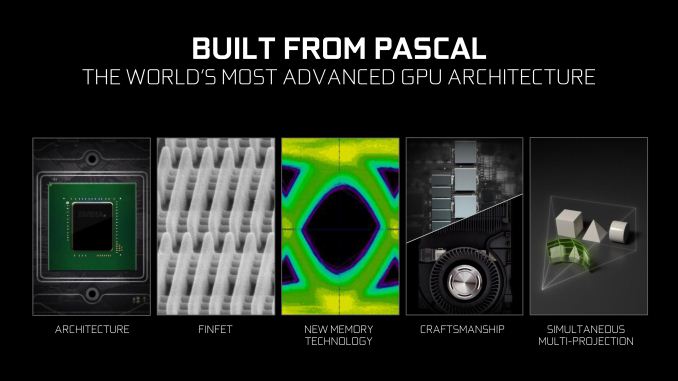
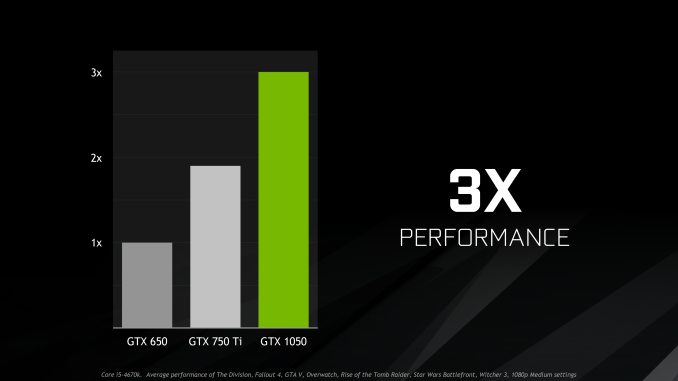
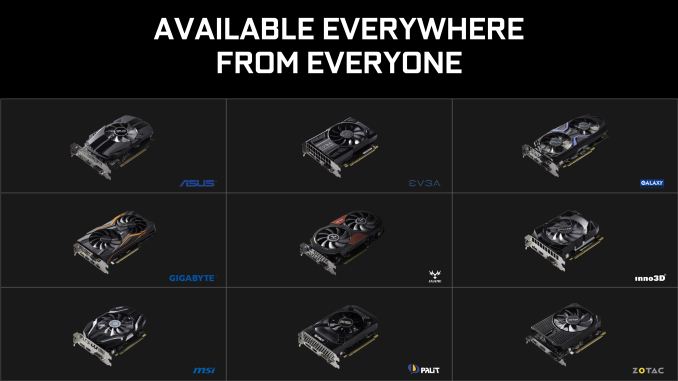














93 Comments
View All Comments
damianrobertjones - Tuesday, October 18, 2016 - link
I'm sure that you're all aware of this but, before you buy, at least consider buying a second hand card from ebay after checking out reviews. You might get a faster card, cheaper, than these new ones. It'll also help with nvidia lowering prices.prisonerX - Tuesday, October 18, 2016 - link
Or, to save even more money, you could draw your own 3D images with paper and pencil.Morawka - Tuesday, October 18, 2016 - link
We'll show nvidia!!!! You think the Founders Edition price gouging rants were bad, just wait until we are all gaming on paper, and with a pencil controller!ant6n - Wednesday, October 19, 2016 - link
Performance will be very poor, on the order of 3e-8 MFLOPs. Even if the paper and the pencil only cost a cent, price/performance will be very poor as well.Sivar - Wednesday, October 19, 2016 - link
Finally, a serious analysis! :)lolipopman - Tuesday, October 18, 2016 - link
Do you really think the people that buy these cards would be willing to spend on new power supplies and additional power connectors?peterfares - Tuesday, October 18, 2016 - link
People who are trying to maximize performance out of a 75W PCI-E slot without external power will need to buy these, but there's bound to be plenty of people who do have the connector and are just looking at ~$120 cards.Siana - Monday, November 28, 2016 - link
I'm running a 700W power supply left over from when i had a GTX295, which i just hated, i couldn't get rid of the heat it generates. Incidentally, the power supply is a bit weird and reaches surprisingly high efficiency within the first 20%, so it isn't exactly asking to be loaded up all the way. And i've been using a 750TI OC on it now which has a power supply connector and is unthrottled. I'll be considering a midrange GPU for my next upgrade too. As a matter of fact, most midrange GPU users that built their PC before that, will likely have power supplies equipped correspondingly, because up until recently, you needed 100W for a barely reasonable unit. Besides, there's nothing terribly wrong feeding mere 5A through a double Molex adapter, cheap too.Samus - Wednesday, October 19, 2016 - link
I don't know, the vanilla 1050 for $109 is going to be a monster card for the price as an entry level gaming card.But for people thinking about 1060's and up, yeah, consider a used GTX 980 on eBay for ~$200 or if you need more than 4GB VRAM, a used 980Ti 6GB for ~$250 which is pretty much on par with a 1070 at 4K and sells for nearly double.
firerod1 - Wednesday, October 19, 2016 - link
Seriously its faster than the 950 and that card launched at 159$. So the 1050Ti is a great value at 139$ for faster than 960 performance and one more GB VRAM than the 1060 3GB lulz.